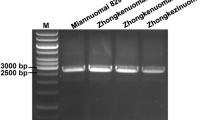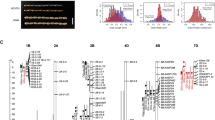Abstract
Waxy protein (granule-bound starch synthase I) is a key enzyme in the synthesis of amylose in endosperm tissue. The amylose content of wheat flour plays a significant role in determining Japanese udon noodle quality. Most wheat cultivars suitable for producing udon noodles have a low amylose level due to a lack of Wx-B1 protein conditioned by null Wx-B1 alleles. It was previously determined that the entire coding region of the wheat Wx-B1 gene is deleted in the most common null allele. However, the extent and breakpoints of the deletion have not been established. In this study, the position of the 3′ deletion breakpoint was refined by mapping with PCR-based markers. Using information from this analysis, a chromosome walk was initiated and the DNA sequence flanking the deletion breakpoints was obtained. The deletion included a 3,872 bp region downstream from the termination codon of Wx-B1 gene. Based on similarity with T. monococcum sequences, it was estimated that approximately 60 kb upstream of the Wx-B1 gene was also deleted. Using this sequence information, a codominant marker for the identification of the Wx-B1 null allele was developed. This marker can unambiguously identify heterozygous plants, which will accelerate the selection of partial waxy mutants carrying the Wx-B1 null allele.






Similar content being viewed by others
References
Boggini G, Cattaneo M, Paganoni C, Vaccino P (2001) Genetic variation for waxy proteins and starch properties in Italian wheat germplasm. Euphytica 119:113–116
Chantret N, Salse J, Sabot F, Rahman S, Bellec A, Laubin B, Dubois I, Dossat C, Sourdille P, Joudrier P, Gautier MF, Cattolico L, Beckert M, Aubourg S, Weissenbach J, Caboche M, Bernard M, Leroy P, Chalhoub B (2005) Molecular basis of evolutionary events that shaped the hardness locus in diploid and polyploid wheat species (Triticum and Aegilops). Plant Cell 17:1033–1045
Corpet F (1988) Multiple sequence alignment with hierarchical clustering. Nucleic Acids Res 16:10881–10890
Feuillet C, Penger A, Gellner K, Mast A, Keller B (2001) Molecular evolution of receptor-like kinase genes in hexaploid wheat. Independent evolution of orthologs after polyploidization and mechanisms of local rearrangements at paralogous loci. Plant Physiol 125:1304–1313
Nakamura T, Vrinten P, Saito M, Konda M (2002) Rapid classification of partial waxy wheats using PCR-based markers. Genome 45:1150–1156
Oda M, Yasuda Y, Okazaki S, Yamauchi Y, Yokoyama Y (1980) A method of flour quality assessment for Japanese noodles. Cereal Chem 57:253–259
Saito M, Konda M, Vrinten P, Nakamura K, Nakamura T (2004) Molecular comparison of waxy null alleles in common wheat and identification of a unique null allele. Theor Appl Genet 108:1205–1211
Saito M, Ishikawa G, Yonemaru J, Nakamura T (2006) Analysis of deletion breakpoints in a wheat null Wx-B1 allele using molecular markers. Breed Res 8:9–16
Sears ER (1966) Nullisomic–tetrasomic combinations in hexaploid wheat. In: Riley R, Lewis KR (eds) Chromosome manipulation and plant genetics. Oliver and Boyd, Edinburgh, pp 29–45
Toyokawa H, Rubenthaler GL, Powers JR, Schanus EG (1989) Japanese noodle qualities. II. Starch components. Cereal Chem 66:387–391
Urbano M, Margiotta B, Colaprico G, Lafiandra D (2002) Waxy proteins in diploid, tetraploid and hexaploid wheats. Plant Breed 121:465–469
Vrinten P, Nakamura T, Yamamori M (1999) Molecular characterization of waxy mutations in wheat. Mol Gen Genet 261:463–471
Wicker T, Yahiaoui N, Guyot R, Schlagenhauf E, Liu ZD, Dubcovsky J, Keller B (2003) Rapid genome divergence at orthologous low molecular weight glutenin loci of the A and Am genomes of wheat. Plant Cell 15:1186–1197
Yamamori M, Nakamura T, Endo TR, Nagamine T (1994) Waxy protein deficiency and chromosomal location of coding genes in common wheat. Theor Appl Genet 89:179–184
Yamamori M, Nakamura T, Kiribuchi-Otobe C (1998) Waxy protein alleles in common and emmer wheat germplasm. Misc Publ Natl Inst Agrobiol Resour 12:57–104
Zhao XC, Batey IL, Sharp PJ, Crosbie G, Barclay I, Wilson R, Morell MK, Appels R (1998) A single genetic locus associated with starch granule properties and noodle quality in wheat. J Cereal Sci 27:7–13
Acknowledgments
We thank the National Institute of Agrobiological Sciences Genebank (Tsukuba, Japan) for providing wheat seeds. This work was partially supported by a grant from the Ministry of Agriculture, Forestry and Fisheries of Japan (Genomics for Agricultural Innovation, FBW-1203).
Author information
Authors and Affiliations
Corresponding author
Rights and permissions
About this article
Cite this article
Saito, M., Vrinten, P., Ishikawa, G. et al. A novel codominant marker for selection of the null Wx-B1 allele in wheat breeding programs. Mol Breeding 23, 209–217 (2009). https://doi.org/10.1007/s11032-008-9226-y
Received:
Accepted:
Published:
Issue Date:
DOI: https://doi.org/10.1007/s11032-008-9226-y




